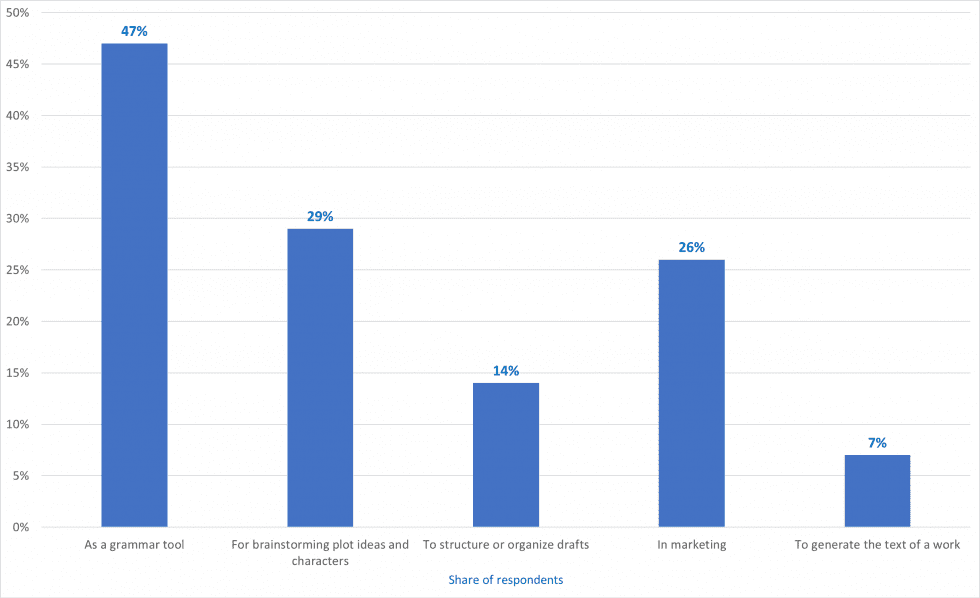Natural Language Processing (NLP) empowers publishers to reduce manual touchpoints and expedite content flow through the publishing pipeline. This accelerates time to market and therefore knowledge dissemination. NLP technologies, such as automated summarization, disambiguation, part-of-speech tagging, context extraction, and linguistic understanding and recognition, have led to the development of large language models (LLMs) that facilitate AI-based language analysis and generation.

Image Source: https://www.statista.com/statistics/1388542/authors-using-ai/
Scholarly authors and publishers are leveraging AI tools for diverse purposes, including the improvement of efficiency, accuracy, and quality of research and content. This article provides a stepwise guide to integrate NLP into existing publishing workflows.
The Pre-Integration Checklist
Before integrating any technology, the existing process should be audited to identify current performance and quality bottlenecks and determine areas of improvement. Next, list out the potential touchpoints where NLP enhancement can expedite or refine the process. You can also seek help from experienced technology providers, like Integra, to gauge the capabilities of NLP and determine how you can make the most of the technology to improve workflows.
Using the touchpoints for NLP integration, define and set clear goals. Establish qualitative and quantitative KPIs for the NLP augmentation. Using these goals, define the software and integration requirements, along with necessary training and skill-building requirements, to effectively leverage the innovative tools.
Steps to Integrating NLP
Integration is rarely a straight-forward process. Enhancing the existing technology stack for API-based tools requires putting together and executing an implementation plan.
Step 1. Data Collection and Preparation
Language models train using existing data, learning its patterns and anomalies. To prepare for NLP integration, start by identifying and collating data from all available sources. Next, clean, structure, and migrate the data to the cloud, where ML models can be trained.
Step 2. Choose the Right NLP Tools
You can choose off-the-shelf NLP solutions or get them customized to your specific requirements. While off-the-shelf options might be cost-effective and offer immediate usability, tools with dedicated purposes will need to be integrated to obtain the overall process improvements. On the other hand, customized tools may take a little more time and investment, but will address specific business requirements and pain points, transforming workflows sustainably for the long term.
Step 3. Implementation in Workflows
With the help of technical teams, perform API integrations, with the content management system (CMS), process monitoring system, work allocation subsystems, etc., to reap comprehensive benefits of NLP enhancement.
Leverage NLP automation for first-level language quality assessment, sentiment analysis, content tagging, keyword extraction, summarization, and much more. This can help in classifying manuscript submissions based on quality, accuracy, and the required level of manual editing to expedite movement.
Step 4. Training and Optimization
Integrate the NLP model training within processes to align its capabilities with your content and facilitate continuous refinement for improved accuracy.
Step 5. Monitoring and Maintenance
Consistently check the relevance and accuracy of model and technology updates to ensure long-term value extraction. Also, monitor the workflows to track the performance, speed, and quality of NLP tools using metrics such as processing time saved, man-hours saved, language accuracy improved, etc., to assess the performance of these tools.
Using the KPIs established, performance data of NLP tools, and business outcomes measure the impact of NLP integration. Use quantifiable benefits such as time saved, content reach improved, and engagement enhanced to measure ROI.
AI Revolutionizing Publishing
While NLP directly works to expedite and enhance manuscript processing, AI integration across business functions aids in managing timelines, mapping reviewers to content according to subject matter, and even marketing. To stay relevant and ahead of the competition, publishers must stay updated with innovations in NLP and other cutting-edge technologies. Partnering with a technology provider with profound AI and NLP integration experience, such as Integra, eliminates the need, time, and costs required to build and maintain in-house technology teams. Schedule a call with the experts to make an informed NLP integration decision.










